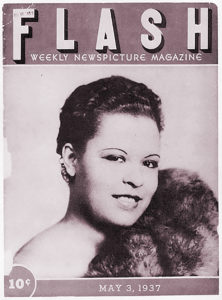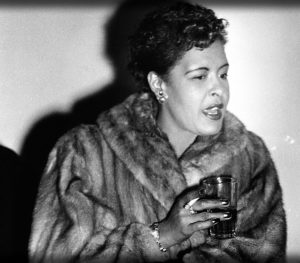Also read The Real Billie Holiday, Part Two – 1940s and Part Three – 1950s
This profile of Billie Holiday is presented in three chapters covering the 1930s, 1940s and 1950s respectively. She’s quoted from interviews and her famed memoir, Lady Sings the Blues. Representative recordings, podcast clips and readings add detail and perspective to each decade of her compelling story. It is notable that photographs of Billie’s mercurial visage are constantly shifting, never the same twice.
Singing Style
It’s not an exaggeration to call Billie Holiday (Eleanora Fagan, 1915-59) the best of all jazz singers. Using her voice as an expressive musical instrument she bent notes like a horn player, blowing along with the cats. Building one of the most distinctive personal singing styles of Twentieth Century music, she revised songs for the better giving them her personal interpretation.
Her power to express a broad range of emotions was rarely equaled in American jazz or popular song. She revolutionized jazz and popular singing, influencing Frank Sinatra, Carmen McCrae, Etta Jones, Dinah Washington, Sarah Vaughn, Anita O’Day and others.
Though she evoked the feeling of the blues and made use of blues tonality, Holiday was primarily a jazz singer. But she sang very few blues lyrics, especially in the early years. Like the best singers, she often transformed and improved songs, many were forever reshaped by her interpretation.
As she explained in her memoir Lady Sings the Blues (1956) – which is quoted throughout this three-part profile:
“I don’t think I’m singing. I feel like I’m playing a horn. I try to improvise like Lester Young, like Louis Armstrong, or someone else I admire. What comes out is what I feel. I hate straight singing. I have to change a tune to my own way of doing it. That’s all I know.”
Billie Pt 1 – 1930s – Podcast clip A.mp3
Personality and Tastes
Holiday claimed she had named herself after actress Billie Dove. But there was more to it:
“My father had started calling me Bill because I was such a young tomboy. I didn’t mind that, but I wanted to be pretty too, and have a pretty name. So I decided Billie was it and I made it stick.”
Tomboy indeed. In contrast to her elegant voice and glamorous public image, Billie was quick to anger and could be downright threatening. Her language was salty and she swore like a sailor. Yet, she could be quite charming, modest and ladylike.

Billie with the Basie Boys. Wrote trumpeter Buck Clayton: “She was great to work with . . . She would shoot dice with us, joke with us and, in general, do everything that we would do. We all liked Billie.”
Holiday did not like riding in trains — hated them — but loved flying. She loved soul food, beans and rice, greens, ham hocks and down-home cooking. And for instance when she toured England, Holiday carried a can of red beans in her suitcase to cook when she got tired of fancy hotel food.
Besides tenor saxophonist Lester Young, musicians she admired first and foremost were Louis Armstrong and Bessie Smith. She was fond of piano player Teddy Wilson, tenor saxophonist Coleman Hawkins and Benny Goodman. Surprisingly, among the singers she mentioned favorably were Kay Starr and Peggy Lee.
Billie Pt 1 – 1950s – Podcast clip B.mp3

First Published image of Billie Holiday, 1937. Note that cosmetics and illumination were manipulated to lighten her skin tone.
- (Page 1 of 2)
- Next page →






Thank you! So nice article !
You can explore Billie’s life, music and associates here:
The official home of Billie Holiday
https://billieholiday.com/
Billie Holiday on Jazz Rhythm
http://www.jazzhotbigstep.com/24201.html
Buck Clayton on Jazz Rhythm
http://www.jazzhotbigstep.com/3905.html
Lester Young on Jazz Rhythm
http://www.jazzhotbigstep.com/161.html
Wonderful!!
Can wait for the next two decades. Keep it coming.
Dear Larry G,
Thank you for your readership and comment. I am pleased to inform you that Part 2 will be published on April 1, 2019.
Sincerely,
Constantine Soo
Dave another wonderful article.
Jack Bybee
Thank you, gentlemen and stay tuned. Everybody loves Billie. Dave R